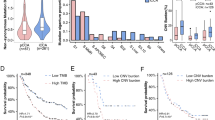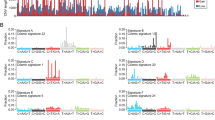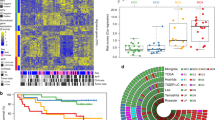Abstract
Through exomic sequencing of 32 intrahepatic cholangiocarcinomas, we discovered frequent inactivating mutations in multiple chromatin-remodeling genes (including BAP1, ARID1A and PBRM1), and mutation in one of these genes occurred in almost half of the carcinomas sequenced. We also identified frequent mutations at previously reported hotspots in the IDH1 and IDH2 genes encoding metabolic enzymes in intrahepatic cholangiocarcinomas. In contrast, TP53 was the most frequently altered gene in a series of nine gallbladder carcinomas. These discoveries highlight the key role of dysregulated chromatin remodeling in intrahepatic cholangiocarcinomas.
This is a preview of subscription content, access via your institution
Access options
Subscribe to this journal
Receive 12 print issues and online access
We are sorry, but there is no personal subscription option available for your country.
Buy this article
- Purchase on SpringerLink
- Instant access to full article PDF
Prices may be subject to local taxes which are calculated during checkout

Similar content being viewed by others
References
Everhart, J.E. & Ruhl, C.E. Burden of digestive diseases in the United States Part III: Liver, biliary tract, and pancreas. Gastroenterology 136, 1134–1144 (2009).
Blechacz, B. et al. Clinical diagnosis and staging of cholangiocarcinoma. Nat. Rev. Gastroenterol. Hepatol. 8, 512–522 (2011).
Borger, D.R. et al. Frequent mutation of isocitrate dehydrogenase IDH1 and IDH2 in cholangiocarcinoma identified through broad-based tumor genotyping. Oncologist 17, 72–79 (2012).
Voss, J.S. et al. Molecular profiling of cholangiocarcinoma shows potential for _targeted therapy treatment decisions. Hum. Pathol. 44, 1216–1222 (2013).
Xu, R.F. et al. KRAS and PIK3CA but not BRAF genes are frequently mutated in Chinese cholangiocarcinoma patients. Biomed. Pharmacother. 65, 22–26 (2011).
Chuang, S.C. et al. Immunohistochemical study of DPC4 and p53 proteins in gallbladder and bile duct cancers. World J. Surg. 28, 995–1000 (2004).
Tannapfel, A. et al. Genetic and epigenetic alterations of the INK4a-ARF pathway in cholangiocarcinoma. J. Pathol. 197, 624–631 (2002).
Yan, H. et al. IDH1 and IDH2 mutations in gliomas. N. Engl. J. Med. 360, 765–773 (2009).
Parwani, A.V. et al. Immunohistochemical and genetic analysis of non-small cell and small cell gallbladder carcinoma and their precursor lesions. Mod. Pathol. 16, 299–308 (2003).
Yanagisawa, N. et al. More frequent β-catenin exon 3 mutations in gallbladder adenomas than in carcinomas indicate different lineages. Cancer Res. 61, 19–22 (2001).
Murali, R. et al. Tumours associated with BAP1 mutations. Pathology 45, 116–126 (2013).
Jones, S. et al. Somatic mutations in the chromatin remodeling gene ARID1A occur in several tumor types. Hum. Mutat. 33, 100–103 (2012).
Varela, I. et al. Exome sequencing identifies frequent mutation of the SWI/SNF complex gene PBRM1 in renal carcinoma. Nature 469, 539–542 (2011).
Ma, X. et al. Histone deacetylase inhibitors: current status and overview of recent clinical trials. Drugs 69, 1911–1934 (2009).
Ong, C.K. et al. Exome sequencing of liver fluke–associated cholangiocarcinoma. Nat. Genet. 44, 690–693 (2012).
Wang, P. et al. Mutations in isocitrate dehydrogenase 1 and 2 occur frequently in intrahepatic cholangiocarcinomas and share hypermethylation _targets with glioblastomas. Oncogene 32, 3091–3100 (2013).
Pollock, P.M. et al. Frequent activating FGFR2 mutations in endometrial carcinomas parallel germline mutations associated with craniosynostosis and skeletal dysplasia syndromes. Oncogene 26, 7158–7162 (2007).
Wu, Y.M. et al. Identification of _targetable FGFR gene fusions in diverse cancers. Cancer Discov. 3, 636–647 (2013).
Sjöblom, T. et al. The consensus coding sequences of human breast and colorectal cancers. Science 314, 268–274 (2006).
Kan, Z. et al. Diverse somatic mutation patterns and pathway alterations in human cancers. Nature 466, 869–873 (2010).
Mielke, P.W. et al. Combining probability values from independent permutation tests: a discrete analog of Fisher's classical method. Psychol. Rep. 95, 449–458 (2004).
Acknowledgements
The authors wish to acknowledge the following funding sources: the Virginia and D.K. Ludwig Fund for Cancer Research; the Lustgarten Foundation for Pancreatic Cancer Research; US National Institutes of Health (NIH) grants P50 CA62924, K08DK090154 and EDRN U01CA086402; Associazione Italiana Ricerca Cancro (AIRC grants 12182, 11930, 6421 and IG 12214); and Italian Cancer Genome Project FIRB RBAP10AHJB.
Author information
Authors and Affiliations
Contributions
T.M.P., R.A.A., A.S., R.K., V.E.V., R.H.H., B.V., K.W.K., N.P. and L.D.W. jointly supervised research. Y.J., F.M.S., A. Maitra, M.F., M.S., A. Mafficini, P.C., R.T.L., A.R., A.G., G.T., F.d.B., A.S., R.K., V.E.V., R.H.H., B.V., K.W.K., N.P. and L.D.W. conceived and designed experiments. Y.J., M.M.S., A. Maitra, G.J.A.O., J.C.R., L.R.R., G.J.G., I.P., S.T.A., S.D., M.F., M.S., A. Mafficini, P.C., R.T.L., A.R., A.G., G.T., F.d.B., A.S., D.K., B.V., K.W.K., N.P. and L.D.W. performed experiments. T.M.P., R.A.A., D.J.L., N.N., V.B.G., R.K., K.W.K., N.P. and L.D.W. performed statistical analysis. Y.J., T.M.P., R.A.A., D.J.L., N.N., V.B.G., M.F., M.S., A. Mafficini, P.C., R.T.L., A.R., A.G., G.T., F.d.B., A.S., W.J., D.K., R.K., R.H.H., B.V., K.W.K., N.P. and L.D.W. analyzed data. F.M.S., M.M.S., A. Maitra, P.A., G.J.A.O., J.C.R., L.R.R., G.J.G., I.P., S.T.A., S.D., M.F., M.S., A. Mafficini, P.C., R.T.L., A.R., A.G., G.T., F.d.B., A.S., W.J., D.K., R.K., V.E.V., R.H.H., B.V., K.W.K., N.P. and L.D.W. contributed reagents, materials or analysis tools. Y.J., T.M.P., R.A.A., F.M.S., A. Maitra, D.K., R.H.H., B.V., K.W.K., N.P. and L.D.W. wrote the manuscript.
Corresponding authors
Ethics declarations
Competing interests
Under agreements between Johns Hopkins University, Genzyme, Myriad Genetics, Exact Sciences, Inostics, Qiagen, Invitrogen and Personal Genome Diagnostics, V.E.V., N.P., B.V., K.W.K. and R.H.H. are entitled to a share of the royalties received by Johns Hopkins University on sales of products related to genes and technologies described in this manuscript. V.E.V., N.P., B.V. and K.W.K. are cofounders of Inostics and Personal Genome Diagnostics, are members of their scientific advisory boards and own Inostics and Personal Genome Diagnostics stock, which is subject to certain restrictions under Johns Hopkins University policy. L.D.W. is a paid consultant for Personal Genome Diagnostics. The contribution of D.J.L. to this manuscript represents his own views and not the official policy of the US Navy, US Department of Defense or US government.
Supplementary information
Supplementary Text and Figures
Supplementary Tables 1–3, 5, 6 and 8 and Supplementary Figure 1 (PDF 4658 kb)
Supplementary Table 4
Somatic mutations in intrahepatic cholangiocarcinoma and gallbladder carcinoma (XLSX 126 kb)
Supplementary Table 7
Summary of prevalence screen for intrahepatic cholangiocarcinoma and gallbladder carcinoma (XLSX 24 kb)
Rights and permissions
About this article
Cite this article
Jiao, Y., Pawlik, T., Anders, R. et al. Exome sequencing identifies frequent inactivating mutations in BAP1, ARID1A and PBRM1 in intrahepatic cholangiocarcinomas. Nat Genet 45, 1470–1473 (2013). https://doi.org/10.1038/ng.2813
Received:
Accepted:
Published:
Issue Date:
DOI: https://doi.org/10.1038/ng.2813
This article is cited by
-
Prognostic implications of tumor histology and microenvironment in surgically resected intrahepatic cholangiocarcinoma: a single institutional experience
Virchows Archiv (2024)
-
Epigenetic dysregulation-mediated COL12A1 upregulation predicts worse outcome in intrahepatic cholangiocarcinoma patients
Clinical Epigenetics (2023)
-
Organoid models of fibrolamellar carcinoma mutations reveal hepatocyte transdifferentiation through cooperative BAP1 and PRKAR2A loss
Nature Communications (2023)
-
Significance of Distinct Liquid Biopsy Compartments in Evaluating Somatic Mutations for _targeted Therapy Selection in Cancer of Unknown Primary
Journal of Gastrointestinal Cancer (2023)
-
Research trends of _targeted therapy for cholangiocarcinoma from 2003 to 2022: a bibliometric and visual analysis
Clinical and Experimental Medicine (2023)



